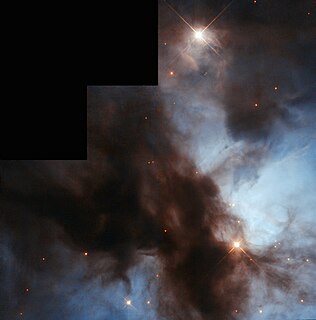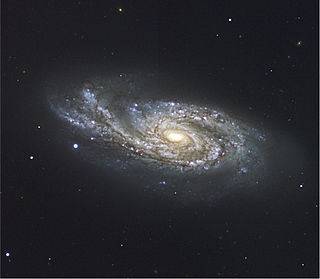
Messier 35 or M35, also known as NGC 2168, is a relatively close open cluster of stars in the west of Gemini, at about the declination of the sun when the latter is at June solstice. It was discovered by Philippe Loys de Chéseaux around 1745 and independently discovered by John Bevis before 1750. It is scattered over part of the sky almost the size of the full moon and is 3,870 light-years away. The compact open cluster NGC 2158 lies directly southwest of it.

Messier 60 or M60, also known as NGC 4649, is an elliptical galaxy approximately 57 million light-years away in the equatorial constellation of Virgo. Together with NGC 4647, it forms a pair known as Arp 116. Messier 60 and nearby elliptical galaxy Messier 59 were discovered by Johann Gottfried Koehler in April 1779, observing a comet in the same part of the sky. Charles Messier added both to his catalogue about three days after this.

NGC 1532, also known as Haley's Coronet, is an edge-on barred spiral galaxy located approximately 50 million light-years from the Solar System in the constellation Eridanus. The galaxy was discovered by James Dunlop on 29 October 1826. One supernova, SN 1981A, has been recorded in the galaxy.

NGC 1872 is an open cluster within the Large Magellanic Cloud in the constellation Dorado. It was discovered by James Dunlop in 1826.

NGC 5548 is a Type I Seyfert galaxy with a bright, active nucleus. This activity is caused by matter flowing onto a 65 million solar mass (M☉) supermassive black hole at the core. Morphologically, this is an unbarred lenticular galaxy with tightly-wound spiral arms, while shell and tidal tail features suggest that it has undergone a cosmologically-recent merger or interaction event. NGC 5548 is approximately 245 million light years away and appears in the constellation Boötes. The apparent visual magnitude of NGC 5548 is approximately 13.3 in the V band.

NGC 2291 is an unbarred lenticular galaxy in the constellation Gemini. It was discovered by John Herschel on January 22, 1827. The visual magnitude is 13, and the apparent size is 1.0 by 0.8 arc minutes.

NGC 2775 is a spiral galaxy in the northern constellation of Cancer, located at a distance of 67 megalight-years from the Milky Way. It was discovered by William Herschel in 1783. NGC 2775 belongs to the Antlia-Hydra Cluster of galaxies and is the most prominent member of a small galaxy group known as NGC 2775 group, part of the Virgo Supercluster, along with the Local Group. Other members of the NGC 2775 group include NGC 2777 and UGC 4781.

NGC 1579 is a diffuse nebula located in the constellation of Perseus. It is referred to as the Northern Trifid because of its similar appearance to the Trifid Nebula, which is located in the southern celestial hemisphere of the sky. It is a H II region, a region of star formation.

NGC 3377 is an elliptical galaxy in the constellation Leo. It is a member of the M96 Group and is about 26 Mly away, with a diameter of approximately 40 000 ly. The supermassive black hole at the core of NGC 3377 has a mass of 8.0+0.5
−0.6×107 M☉. A very faint companion galaxy, NGC 3377A is 7.1' NW.

NGC 654 is an open cluster in the constellation Cassiopeia. It was discovered by William Herschel in 1787. With apparent magnitude 6.5, it can be observed by binoculars. It is located 2,5° northeast of the star Delta Cassiopeiae. In the same low power field can also be seen the open clusters NGC 663 and NGC 659. It surrounds a 7th magnitude yellowish star, an F5Ia supergiant, which is a possible member of the group.

NGC 908 is an unbarred spiral galaxy in the constellation Cetus. It is 60 million light years away from Earth. NGC 908 has vigorous star formation and is a starburst galaxy. The galaxy has a three-arm spiral pattern; two of its arms have peculiar morphology. The galaxy has a bright central bulge. Clusters of young stars and star-forming knots can be seen in the arms. Starburst activity and the peculiar morphology of the galaxy indicate it had a close encounter with another galaxy, although none are visible now. NGC 908 was discovered in 1786 by William Herschel. Two supernovae have been observed in NGC 908, SN 1994ai and SN 2006ce. It is the main galaxy in the NGC 908 group, which also includes NGC 899, NGC 907, and IC 223.

NGC 4707 is an irregular galaxy in the constellation of Canes Venatici. It was discovered by John Herschel on 5 June 1834, and was described by John Louis Emil Dreyer, the compiler of the New General Catalogue, as a "small, stellar" galaxy.

NGC 6939 is an open cluster in the constellation Cepheus. It was discovered by William Herschel in 1798. The cluster lies 2/3° northwest from the spiral galaxy NGC 6946. The cluster lies approximately 4.000 light years away and it is over a billion years old.

NGC 4699 is an intermediate spiral galaxy located in the constellation Virgo. It is located at a distance of circa 65 million light years from Earth, which, given its apparent dimensions, means that NGC 4699 is about 85,000 light years across. It was discovered by William Herschel in 1786.

NGC 5617 is an open cluster in the constellation Centaurus. NGC 5617 forms a binary open cluster with Trumpler 22. It lies one degree west-northwest of Alpha Centauri.

NGC 2623/Arp 243 is an interacting galaxy located in the constellation Cancer. NGC 2623 is the result of two spiral galaxies that have merged. Scientists believe that this situation is similar to what will occur to the Milky Way, which contains our solar system, and the neighboring galaxy, the Andromeda Galaxy in four billion years. Studying this galaxy and its properties have provided scientists with a better idea of the coming collision of the Milky Way and the Andromeda. Due to NGC 2623 being in the late stage of merging, the compression of the gas within the galaxy has led to a large amount of star formation, and to its unique structure of a bright core with two extending tidal tails.

NGC 4242 is a spiral galaxy in the northern constellation of Canes Venatici. The galaxy is about 18 million light years away. It was discovered on 10 April 1788 by William Herschel, and it was described as "very faint, considerably large, irregular, round, very gradually brighter in the middle, resolvable" by John Louis Emil Dreyer, the compiler of the New General Catalogue.

NGC 1380 is a lenticular galaxy located in the constellation Fornax. It is located at a distance of circa 60 million light years from Earth, which, given its apparent dimensions, means that NGC 1380 is about 85,000 light years across. It was discovered by James Dunlop on September 2, 1826. It is a member of the Fornax Cluster.

NGC 691 is an unbarred spiral galaxy located in the constellation Aries. It is located at a distance of circa 120 million light years from Earth, which, given its apparent dimensions, means that NGC 691 is about 130,000 light years across. It was discovered by William Herschel on November 13, 1786.

NGC 701 is a spiral galaxy with a high star formation rate in the constellation Cetus. It is estimated to be 86 million light years from the Milky Way and has a diameter of approximately 65,000 light years. The object was discovered on January 10, 1785 by the German-British astronomer William Herschel.




















